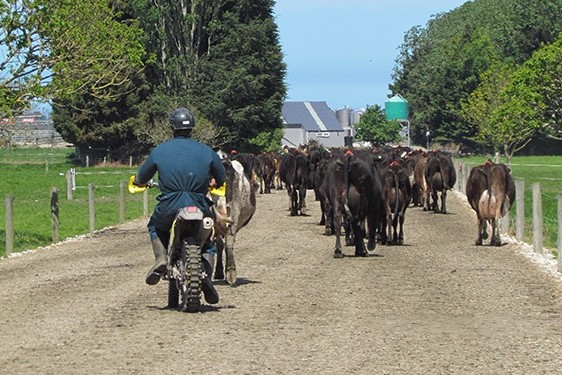Increasing numbers of farm and dairy workers are being infected by leptospirosis, Elaine Fisher reports.
Leptospirosis infections in New Zealand are on the increase and those most affected are dairy workers, other farmers and farm workers, a leading researcher in the field, Dr Julie Collins-Emerson says.
“From 2017-2019 there has been an approximate 60% increase in the numbers of human-notified cases compared to the previous five-year period with nearly half of those hospitalised,” she says. Julie is EpiLab Laboratory Manager and Senior Research Officer, Hopkirk Research Institute School of Veterinary Science at Massey University.
Disturbingly, she says analysis suggests there could be 22 times the number of lepto cases as those reported.
“Nearly half of those who are diagnosed with lepto are still unwell nine months later and experiencing symptoms like chronic fatigue (not unlike the long-haul Covid-type syndrome).
“This can take a huge personal toll on people, impacting their ability to work/earn an income, affecting their mental health and indirectly affecting their families/whanau and communities.”
The reason infections are on the rise may not be complacency but more a case of people not appreciating that the disease profile can change and therefore not being up-to-date with the latest information.
“I was interviewing a sheep and dairy farmer the other day who had contracted lepto. He knew about lepto in dairy and vaccinated his cows but was unaware that it was also in sheep and therefore a risk to him.
“It is also a challenge for researchers to get the messages out there. It is understanding that the methods of information we as researchers tend to use, is not the same as many farmers favour.
“For example, the farmer said he rarely looked at the computer and relied on talking to other farmers, stock and station agents, his veterinarian and rural media sources of information.
“That was really useful for our team as it helps us to find better ways of providing access to relevant information about lepto for the rural community.”
Crucial steps to reducing the risk of infection include;
- Avoid getting urine on yourself and be careful of urine contaminated surfaces or environments and that includes animal hides, yard fencing, mud, wash-down water/aerosol sprays from milking sheds and stock trucks.
- Cover any wounds/cuts with waterproof bandaging and wear suitable protective clothing, eg: aprons, boots, visors, gloves.
- Always wash and dry your hands before eating.
- Remember children on the farm, e.g: kids in the milking shed, and make sure they have covered footwear as well.

Early intervention important
Early intervention with antibiotics can help reduce the severity and long-term effects of lepto.
“If you have symptoms, that can include: fever, headache, nausea, muscle aches/weakness and fatigue, see your GP and inform them that you may have been exposed to leptospirosis,” Julie says.
“The disease can range from a mild, flu-like illness to something that is deadly. Fortunately, not too many people in NZ have died from it. However, because the symptoms can be mistaken as flu and, due to complexities associated with diagnostics or even a lack of suspicion of the disease, many cases of lepto go undiagnosed.”
- Wild animals including pigs, possums, rats, mice and hedgehogs carry lepto to one degree or another and shed it in their urine.
- People should be careful when handling these animals, especially if emptying traps or coming into contact with their urine directly or indirectly.
- Stockfeed can be contaminated with rodent urine and people can pick up lepto through open cuts or wounds.
- Lepto can also survive for varying amounts of time in the soil, particularly moist soil. Research by the team found pathogenic lepto in many environmental samples e.g: soil/water puddles on a dairy farm.”
Vaccination best form of defence
There is no vaccine for humans but all the livestock vaccines, irrespective of brand are effective. “Where there does seem to be breakdowns in protection is when calves are vaccinated too late and already have the disease, and when other animals are brought on to the farm and their vaccination status has not been checked. It used to be suggested that calves be vaccinated around six months of age as there was concern that maternal antibodies may interfere with vaccination effectiveness.
“It has more recently been demonstrated that calves as young as six weeks can safely start the vaccination programme. I think that is the key as well, trying to fit the lepto vaccination programme in with what else is happening on the farm and I know calving is a busy time. Then it is a case of maintaining that annual booster for the adult animals.”
Currently there is no vaccine for the novel variant of the serovar Tarassovi or Ballum, another serovar increasingly affecting humans.
Nationally, vaccination rates for sheep, beef cattle, and deer are low. The leptospires can cycle through different stock classes on a farm so these animals are a risk if not vaccinated.
“You can talk to your vet if you are interested in exploring vaccination of other animals including farm dogs.”
Lepto was known as “Dairy Farm Fever” or “Swineherd’s Disease” as it was associated mainly with the dairy and pig industries. In early 1980 the introduction of vaccination against the dominant strains in those animals at the time, which were serovars Hardjo and Pomona, corresponded with a huge reduction in human cases in NZ.
“For a long time afterwards, leptospirosis cases were strongly linked to exposure in the meatworks. Changes in processing and increased use of personal protective equipment has been linked to a significant decrease in the incidence of leptospirosis in meat workers – but it has not gone away.”
Julie began leptospirosis research in 1991 as a postdoctoral fellow with Associate Professor Roger Marshall who was one of the pioneers in NZ lepto research in the 1970s and 80s.
“What has kept me in the research area is that leptospirosis is a dynamic disease. The epidemiological landscape shifts including changes in dominant types of lepto (serovars) and the host animals they are associated with. It is influenced by climate change, human activities such as altered farming systems and the pressure human population growth places at the urban/rural boundaries and how that can affect wildlife and the environment.
“Also, the bacterium itself evolves and leptospirosis is classified as both an emerging and re-emerging disease. This is intellectually of interest, but what keeps myself and many colleagues engaged is that leptospirosis has a huge impact around the world on people’s livelihoods and health, particularly in low-income countries.
“Additionally, New Zealand is unusual – it has an island biogeography – the lepto we have here includes a limited number of serovars and they have all arrived in mammals imported from overseas. Leptospirosis therefore has a very different profile here.
“This gives NZ an insight into, and the ability to do leptospirosis research here that proves more difficult and confounded than overseas due to the increased types of Leptospira circulating, particularly in the wildlife.
“The real difference this research can make to so many people’s lives is what is so rewarding,” Julie says.
Also contributing to the lepto in dairy cattle research are: Prof. Jackie Benschop, Dr Shahista Nisa, Dr Supatsak Subharat, Maryna Sokolova and Stuart Littlejohn. More information can be found on the group’s website: leptospirosis.org.nz
DISEASE CHANGES COURSE
A variant of leptospirosis is providing challenges for Massey University Researchers, says Dr Julie Collins- Emerson.
In recent years there has been a change in the occupations most closely associated with leptospirosis. It is now more commonly notified in people who are dairy workers and other farmers/farm workers.
“In dairy workers, it seems to be linked to a novel variant of the serovar Tarassovi. Ballum, another serovar increasingly affecting humans, has been found with a high prevalence in mice in a study done by the Massey University Leptospirosis Research Group.
“To enable a greater understanding of novel variant of the Tarassovi serovar researchers at Massey have been trying to isolate the bacterium from cow urine by culturing it with the aim of doing further studies on it.
“We would like to do whole genome sequencing of the bacterium, not unlike what they are doing with the various Covid-19 strains, so that we can better understand the nature of the organism. At this stage, the small fragments of bacterial DNA that we have been able to sequence suggest it is unlike other lepto species we have in New Zealand.
“However, we need live organisms to grow in the lab so that we have enough quality DNA to do that work. Unfortunately, it is a particularly recalcitrant organism and so far we have not been able to successfully grow it.
“Colleagues in New Caledonia are having the same issue. However, we have identified herds with a high prevalence and are focusing on these to both try and isolate and also look at production data to see how the bacterium may affect the cows. Another reason for trying to isolate this variant is for use in future vaccine development.”





